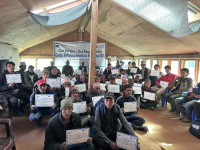Culture & Lifestyle
Cultural plays in Nepali theatres
Pachali Bhairab, a cultural play presented by Bajra Kala Kunja in Kausi Theatre, showcased how impactful cultural plays can be. But, such plays need support from locals and the government to continue.
Shranup Tandukar
Inside the dark theatre hall of Kausi Theatre, the seats were all occupied and the air was stuffy. The audience echoed the same emotions like a single gigantic organism; laughing together when Rukmani gets teased by her friends, gasping together when Palambar revealed his real avatar, and feeling sorrow when Rukmani almost loses her son. Each time a new cultural dance pushed the plot forward, the audience's gaze became more transfixed on the stage.
The recently concluded cultural play, Pachali Bhairav was performed in Kausi Theatre, Teku from November 11 to November 20. The production team of Pachali Bhairav, headed by director Chandraman Munikar and co-director Ingi Hopo Koinch Sunuwar, is now gearing up to tour different cities throughout the country performing the play. Their group is scheduled to start the two-week tour from mid-December.
“The plan for performing in a theatre in Pokhara has already been confirmed, and we are also aiming to perform in different places such as Damauli, Lamjung, Narayanghat, etc,” says Chandraman Munikar.
The play, which Bajra Kala Kunja presented, was a breath of fresh air in the theatre scene of the Valley. Amidst the popularity of adaptations of foreign plays in theatres in the Valley, the successful production of Pachali Bhairav asserted that a cultural play can be just as popular and beloved by the theatre audiences as any other foreign play. However, the theatre scene in Nepal is a struggling industry, and a cultural play such as Pachali Bhairav would not have been possible without support from the local community and government, say the play organisers.
From ‘Harek Babaal Kura’, ‘As You Like it’ to ‘Anupasthit Teen’, foreign adaptations of plays have dominated the Valley's theatre scene after the coronavirus-induced lockdowns. Currently, ‘Stop Kiss’ by Diana Son is being performed in One World Theatre whereas an adaptation of ‘Animal Farm’ is slated to begin at Kausi Theatre from November 30.
“I have been involved in the theatre scene for 40 years already, and it pains me to see contemporary theatres and directors opting for adaptations of foreign plays rather than stories of local Nepali context. We have many mythological, cultural, and traditional stories that can be adapted into plays,” says Munikar. “I personally think that art and culture are universal; we should expose ourselves to different cultures and celebrate them. We decided on doing a play on Pachali Bhairav because it is closely related to the history and origin of the Valley.”
However, the journey of adapting an age-old story into a play was not an easy feat. Stories fray and splinter into different versions as time passes, especially in the case of oral stories. The story of Pachali Bhairav also has different versions. In one version, Pachali Bhairav is a king of Pharping; in another, he was a farmer; and in the case of the ‘Pachali Bhairav’ play, he was a Kirati king who visited Pachali(a neighbourhood in Teku) to meditate.
Munikar informs that he met up with more than 12 different cultural experts to come up with a unifying story about Pachali Bhairav. “In my opinion, the story of Pachali Bhairav is important in the cultural identity of about eight different Newa communities such as Maharjan, Khadgi, Shahi, etc. So, I also talked with people of these different communities to come up with the draft of the play,” says Munikar.
Ingi Hopo Koinch Sunuwar, the play's co-director and actor, helped transform the story into a script format for the play. Though not belonging to the Newa community, Sunuwar is a resident of Teku and had always known about the reverence towards the Pachali Bhairav temple in his locality from his childhood days. However, he still faced difficulties capturing the nuances of Newa culture.
“There was a lot of research involved and back and forth between cultural experts to finalise the script. Also, since it is a cultural play rooted in myths and traditions, there were fewer avenues of creative freedom,” says Sunuwar. “But surprisingly, the closed confines also helped foster creativity.”
The story of Pachali Bhairav at its heart is a love story about two lovers who were separated from each other; while weaving the love story, it also explores the societal stigma surrounding love affairs and children out of wedlock. In such cases, females are often victimised and bear the brunt of societal oppression.
In the play, Sunuwar pushed for the emphasis on feminist perspectives to the ancient tale. He refers to Rukmani’s dialogue to Pachali Bhairav in the play, “Naari le je bhogcha tyo purush le bhognai pardaina, bhognai sakdaina. Ani bhogdai nabhogeko kura kasari bujhnu huncha?”( A male never has to endure what a female endures; he possibly cannot. So, how can you claim to understand something that you never experienced?)
“In many ancient tales, there are depictions and portrayals of sacrifices of women. Their sacrifices and acts are emphasised but their inner feelings and emotions through dialogues and speech are less explored,” says Sunuwar. “That’s why we focused on writing dialogues which could relay the raw emotions and turmoil of Rukmani in the play.”
The fleshing out of the characters and emphasis on the dialogues in a play help create a memorable experience, says Chunda Bajracharya, cultural expert and retired professor of Nepalbhasa at Tribhuvan University. And therein lies the power of theatre and plays which separate it from other mediums of art. “Our culture and tradition are often portrayed through dances during jatras. However, the initiative to turn the stories of our jatras into plays is a welcome one and should be appreciated.”
“The difference between cultural dances and cultural plays is that a play can push the boundary between reality and stories,” says Munikar. “When you watch a play, the story gets deeply imprinted in your mind. Rukmani becomes Anisha Shrestha(the actress who played her part), and Anisha becomes Rupamani in the eyes of the audience.”
Shamir Amir Kansakar, a resident of New Road, also watched the play after hearing about it through his friends. He was impressed by the depictions of cultural and traditional aspects of the Newa community in the play. “I didn't find any superficial portrayal but a nuanced and contextual depiction of the story of Pachali Bhairav,” he says. “In cultural dances and jatras, there is a lot of symbolism and nuances involved, so people from outside the community may not fully understand the story underneath the surface. However, with its dialogues and scene-setting, the play goes into the depths and explains the story for everyone.”
Aside from the difficulties of converting an age-old story into a play format, the financial sides of theatre production were difficult to navigate for the play's organisers. The Kathmandu Metropolitan City (KMC) supported the play, and Munikar states, “The play would not have been possible without the financial aid from the city.”
Dipak Adhikari, department head of the Cultural Development Department of the KMC, informed the Post that Bajra Kala Kunja had been provided with a financial aid of Rs 1.2 million to produce the Pachali Bhairav play.
Theatre production is different from the production of other digital content like movies. A movie production can have substantial initial production costs, but after the movie has finished filming, the digital copy of the movie can be distributed with nominal costs, and there will be no subsequent costs for further showings. However, in the case of theatre plays, in addition to the initial production cost, each showing of the play will incur additional costs in the form of the actor performance fee, venue lease fee, and costume lease fee, among others. Munikar informed that the costs of the various traditional masks for the play itself cost almost Rs 100,000.
“There are 16 theatre artists involved in the play who need to be compensated for all the practice sessions as well as the actual performance days. The financial burden of producing a play is too much if there is no support from locals and government,” says Munikar. “If I had to do it myself, then I would have had to sell a house to finance one play then sell some other land to finance the next plays.”




 18.12°C Kathmandu
18.12°C Kathmandu















